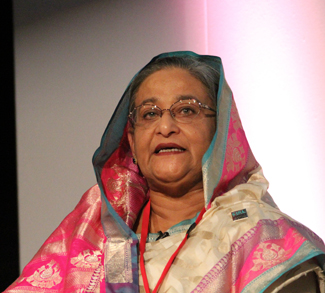Since ISIS burst onto the scene after rampaging through northern Syria and Iraq more than three years ago, Southeast Asia’s Muslim-majority countries have been concerned that the new wave of terrorism would eventually spread to their region.
These fears have indeed been realized: a deadly gun and bomb attack rocked Jakarta, killing four civilians in January 2016; whilst last year, ISIS-inspired militants laid siege to the southern Philippine city of Marawi for more than five months, resulting in hundreds of deaths and brazenly confirming the arrival of a dangerous new era of jihadism in Southeast Asia.
Malaysia is one Southeast Asian country that’s taking the threat particularly seriously. There is a very real risk of fighters returning from Syria, Iraq, and Marawi launching attacks in Malaysia, in addition to the threat emanating from ISIS’ online recruitment and radicalization efforts aimed at inspiring sympathizers to carry-out low-tech, lone-wolf attacks.
Yet despite the rise of ISIS and the recent deterioration of the security situations of neighboring countries, Malaysia has continued to enhance its record of counterterrorism success, and a major Islamist attack within its borders has so far been prevented. This report assesses how Malaysia has avoided suffering the same fate as other countries in Southeast Asia, and asks if its strong record in thwarting attacks can be sustained amid a rapidly shifting regional threat outlook.
The evolving threat from Islamist terror
Malaysia has long possessed an excellent counterterrorism record. In past decades, domestic terror groups such as Kumpulan Mujahidin Malaysia (KMM), regional groups such as Jemaah Islamiyah (JI), and transnational groups such as Al-Qaeda have all been thwarted at one time by the Malaysian authorities. In the 2000s, as neighboring Indonesia was shaken by a wave of deadly attacks – most notoriously the JI-claimed Bali nightclub bombings which killed 202 people in October 2002 – Malaysia escaped the decade of elevated risk following 9/11 relatively unscathed, without suffering a major attack.
Regional authorities clamped-down hard on JI and Al-Qaeda, and by 2010 the terrorism threat to Southeast Asia had significantly waned. Yet the sudden and dramatic emergence of ISIS changed all that, causing alarm bells to ring across the region. Soon after ISIS declared its Middle Eastern ‘Caliphate’ in 2014, fears emerged over the growing number of Southeast Asian nationals travelling to join the group as foreign fighters.
The head of Malaysia’s Special Branch Counter-Terrorism Division, Ayob Khan Mydin Pitchay, says at least 53 Malaysians are known to have joined ISIS in Syria. In reality, the number could be far higher. ISIS has even formed a separate armed unit in Syria – known as Katibah Nusantara – made-up solely of Indonesian and Malaysian citizens who have travelled to the region. At least 20 Malaysians are thought to have died on Syrian battlefields, including nine who detonated themselves in suicide bombings. ISIS has also released several Malay-language videos through its Al-Hayat media center, encouraging Malaysians to carry out attacks in their homeland. The recruitment and radicalization of Malaysians has also occurred through social media channels and encrypted messaging apps such as WhatsApp and Telegram, prompting concern over the potential for ISIS-inspired lone-wolf attacks.
The last two years have provided particularly ominous warning signs for Southeast Asian nations. The deadly attack in Jakarta in January 2016 was followed by an ISIS-claimed grenade attack on a nightclub near Kuala Lumpur later that year, which injured eight people but failed to inflict any fatalities. The botched attack was the first to be claimed by ISIS in Malaysia. The five-month siege of Marawi from May-October 2017 has further stoked fears and raised the regional terror threat to its highest level, signifying the arrival of ISIS as a fighting force in Southeast Asia. 2017 also witnessed further suicide blasts and attempted attacks in Indonesia, whilst Philippine authorities continue to battle the ISIS-inspired Bangsamoro Islamic Freedom Fighters (BIFF) in Mindanao.
However, this threat has so far not resulted in large-scale fatal attacks within Malaysian borders. The reason why this is the case has much to do with Malaysia’s multi-faceted counterterror strategy.
Malaysia’s reinforced counterterror strategy
In response to the rise of ISIS in 2014, Malaysia quickly identified the risk and immediately set about reinforcing and upgrading its counterterror measures, as the government in Kuala Lumpur sought to build upon its strong historical record in confronting violent extremism.
Firstly, lawmakers updated anti-terror legislation, replacing the outdated Internal Security Act (ISA) with a raft of new measures. The new Security Offences and Special Measures Act (SOSMA) had already been passed shortly before ISIS emerged in 2014, adding to the existing penal code a range of provisions covering terrorism-related offences and crimes against the state. The listed offences included violent attacks aimed at causing fear, in addition to encouraging terrorist acts and financing, and harboring or providing assistance to terrorists. The new laws enable judges to sentence those convicted of terror offences to lengthy prison sentences, and in some cases even the death penalty.
In 2015, Malaysia also introduced the Prevention of Terrorism Act (POTA) and the Special Measures against Terrorism in Foreign Countries Act (SMATA), giving the police greater powers to arrest and detain individuals, as well as designating two detention centers to house terror suspects. Whilst legitimate human rights concerns have been raised over the powers granted to law enforcement agencies, the updated legislation has thus far achieved its aim of preventing attacks within Malaysia.
The Special Branch Counter-Terrorism Division states that since 2013, 19 large plots have been foiled and more than 340 terror suspects have been detained. The numbers have been increasing year-on-year. In 2013 just four individuals were arrested; that number rose to 59 in 2014, 82 in 2015, and 106 in 2016. In 2017, the number of terror arrests passed the one hundred mark for a second successive year. The country also has one of the highest conviction rates for terror offences, with 101 individuals found guilty and sentenced in the last four years. Whilst these figures indicate an ever-rising threat, they also indicate the increased capability of the Malaysian authorities to respond in turn.
Secondly, Malaysia has sought to crack down on terrorist financing – an area in need of improvement after widespread criticism in the past. Malaysia passed the Anti-Money Laundering and Anti-Terrorism Financing Act (AMLATFA) back in 2001, which required financial institutions to submit suspicious transaction reports (STRs) to the Malaysian Central Bank. Full implementation of these measures was initially weak. However, Malaysia’s compliance with global counter-terror financing standards has improved markedly, and in 2016 it was granted membership to the international Financial Action Task Force (FATF), marking Malaysia out as a country committed to cutting off funding for terrorist groups. These improved anti-terror finance capabilities add to the legislation already discussed, making Malaysia an unattractive base for Islamist terror groups.
Thirdly, Malaysia’s de-radicalization programs are among the most successful in the world. Of the 229 suspects enrolled between 2001 and 2012, only seven relapsed into terrorism-related activities, giving the program a 97% success rate. These efforts are a collaboration between the Ministry of Home Affairs (MoHA), Ministry of Education (MoE), the prison authorities, and religious institutions. Counseling sessions aim to counter extremist interpretations of Islam and successfully reintegrate radicalized individuals back into society, whilst post-release support mechanisms are designed to continually engage both the participant and their family members, lessening the risk of relapse.
Malaysia is often cited as a leading example in the field of de-radicalization, and has willingly shared its expertise and best practice with other nations. In the age of ISIS, Malaysia has also taken steps to combat radicalization online, spearheading a new regional initiative – the Digital Counter-Messaging Centre (CMC) – established in September 2016 to counter extremist ideology in cyberspace.
The threat of returning fighters in 2018
Despite the success of these combined measures in recent years, the threat posed by ISIS is entering a dangerous new phase. In the last few months of 2017, Mosul, Raqqa, and Marawi were wrested from the grip of the jihadists, shrinking the size of ISIS’ territory in the Middle East whilst dealing a hammer blow to its attempt to establish a Southeast Asian caliphate in the southern Philippines.
Security analysts have raised the alarm that, given the collapse of ISIS as a military force, hordes of foreign fighters will now seek to return to their countries of origin, including Malaysia, in 2018.
Malaysia has responded quickly and kept up the pace of its counterterror operations in an attempt to pre-empt the threat. The Navy has taken part in trilateral sea and air patrols in the Sulu Sea since June alongside the armed forces of Indonesia and the Philippines in an attempt to stem the flow of jihadists between Mindanao and the rest of maritime Southeast Asia to the west. In addition, high vigilance has been maintained in the Eastern Sabah Security Zone (ESSZ) to prevent the infiltration of ISIS fighters into Sabah state, which has become Malaysia’s frontline in the battle against militancy.
In October, Malaysian Prime Minister Najib Razak launched a new National Special Operations Force (NSOF), comprising of personnel from the armed forces, police, and the Maritime Enforcement Agency, created to respond immediately and effectively to any terror scenario which may unfold in the country. The units aim to smooth the chain-of-command to ensure a highly coordinated response in the event of an attack. The authorities also conducted a wave of anti-terror raids in the final weeks of 2017, detaining at least 20 individuals in operations in Johor, Sabah, Selangor, and Kuala Lumpur.
Malaysia’s hybrid approach is working
Malaysia has achieved its successes by adopting a combination of ‘hard’ and ‘soft’ measures: a hybrid strategy which approaches the threat from opposite angles. Strengthened counterterrorism legislation and vigilant law enforcement operations tackle the visible threat, whilst sustained de-radicalization initiatives mitigate the threat beneath the surface, challenging the warped ideology that underlies Islamist terrorism. Malaysia has continually emphasized that a military solution alone will not solve the problems of radicalization and violent extremism.
Though Malaysia’s counterterrorism measures have proven highly successful, it remains impossible to eliminate the threat entirely. Low-tech lone-wolf attacks inspired by ISIS remain particularly difficult to prevent. But in a world where a lasting solution to Islamist terrorism appears a distant prospect, Malaysia’s hybrid counterterrorism approach – aimed at preventing attacks and reducing radicalization – serves as the leading example for confronting the scourge of ISIS.




